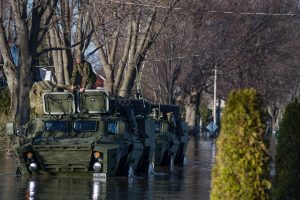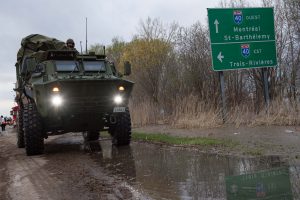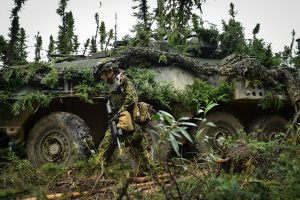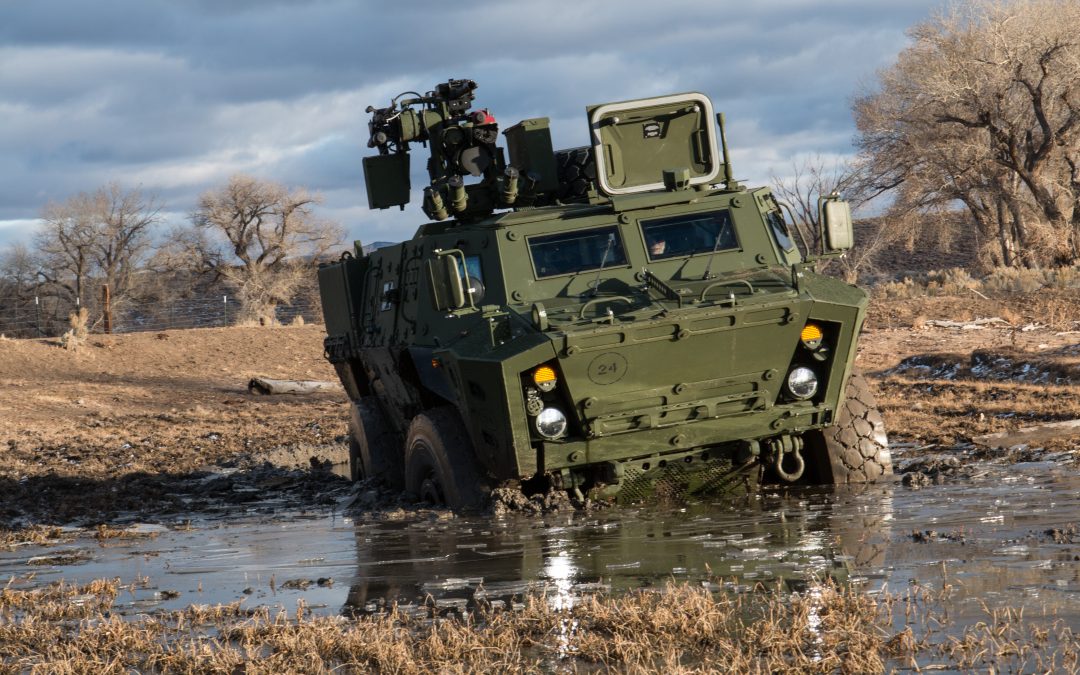by Chris Thatcher
For most Canadians, the first glimpse of the Army’s new tactical armoured patrol vehicle (TAPV) was on the streets of Quebec as it waded through meter-high water, patrolling flooded neighborhoods in Gatineau, Montreal, and Trois-Rivières, ferrying sandbags and other supplies to desperate homeowners.
Despite its high suspension and distinctive amphibious-like hull, the TAPV was never designed to float. Nonetheless, over several weeks in May, as the water crested along swollen riverways, the vehicle easily handled the unusual conditions of its first deployment with the Royal 22nd Regiment.
“It was good feedback for us. We had qualified fording during qualification, but we never thought we were going to be driving through sustained one metre waters for hours at a time,” said Major Steven Grubb, project director since July 2012 of a program that has seen its share of high and low water marks. “It was good to know the TAPV could do everything we thought it could. It actually went through more than one metre depth without any issues at all.”
Water intrusion was one of many considerations during design, but “whether the engineers felt it would exceed the designed-to level of capability was not the original intent,” said Zach Bupp, the program director for Textron Systems Marine & Land Systems. “It is actually designed for fording up to 1.5 metres. I think they were pretty much at that limit [based on] the pictures I saw.”

Tactical Armoured Patrol Vehicles patrol flooded areas in Saint-Barthélemy, Québec during Operation LENTUS, May 12, 2017. Photo: Sgt Marc-André Gaudreault
The vehicles on flood duty were the first of 500 that will eventually operate with Regular and Reserve units across the country. The TAPV was awarded to Textron Systems in June 2012, a $603 million contract to provide two variants – 307 in a general utility configuration and 193 for a reconnaissance role. The vehicles will replace the Army’s RG-31 armoured patrol vehicle and the LAV-II, better known as the Coyote, that has served as the armoured corps’ reconnaissance vehicle. Textron was also awarded a $105 million contract for support of the vehicles.
As the brigade next in the rotation for high readiness training, 5 Canadian Mechanized Brigade Group and various support units of 2nd Canadian Division in Valcartier were among the first to receive the new vehicles, and therefore the first to deploy them in a domestic operation.
Additional TAPVs in both variants have been delivered to the Combat Training Centre in Gagetown to initiate operator training programs for the armoured, infantry and artillery schools, and to units from Montreal to Shilo to Edmonton to begin initial cadre training. 4th Canadian Division, headquartered in Petawawa, will begin taking possession of its first platforms this fall. About 50 percent had been delivered as of early September, Grubb estimated, and the remainder will be received by summer 2018.
Perhaps because of its dual role, it might take some time before the Army fully defines how it plans to employ the TAPV. While the original intent had been to acquire the vehicle for infantry and armoured reconnaissance units and the light battalions, the TAPV is not an infantry fighting vehicle.
“It is meant to carry people who can dismount, but it’s not designed to roll up on an attack like a LAV,” Grubb noted. “When we were first looking at this for the infantry, their thoughts were: ‘How are we going to use this in an advance-to-contact, in a strictly offensive role?’ It doesn’t really work well for that because that is not what it was designed to do. That’s why we have the LAVs and the mechanized infantry battalions.”
At over three metres, however, it is the tallest vehicle in the combat fleet. And with a gross weight of over 18 tonnes when fully armoured, it exceeds the transport capabilities of a CC-130J Hercules or CH-147F Chinook. Consequently, the TAPV is seen now as an Army-wide solution for armoured, artillery and other units using older variants of the LAV II.
“We’re giving some to headquarters and signalers to use for their missions and command and control movement because it has great mobility and is highly protected,” said Grubb. “Some are going to the military police regiments, because in theatre they don’t have that level of protection.”
And how each unit opts to use it will likely evolve over the coming years as they develop their respective techniques, tactics and procedures, he acknowledged. Artillery, for example, might use it to transport and support the CU172 Blackjack unmanned system.
Since the TAPV will only replace the LAV II’s reconnaissance role, the armoured corps is also still evaluating how best to use it, Grubb said. The surveillance or observation post function, which includes an elevated 10-metre surveillance mast, will be filled by the Long Range Surveillance System (LRSS) project, a program to deliver a full surveillance suite and new radar on 66 of the upgraded LAV 6.0 chassis. The TAPV could be paired with LRSS in which the latter serves the more stationary observation post role while the former conducts reconnaissance patrols and feeds back information.
“There is still a lot of training and trialling with the vehicle before the Army gets to the point where they can say, we have an initial operating capability,” he observed.
PRIMACY OF PROTECTION
The origin for the TAPV requirement lies on the IED-infested roads of Afghanistan. When the Army first deployed in 2002, it was with the Bombardier-built variant of the 1980’s era Volkswagen Iltis jeep, a vehicle woefully under-protected for the threat environment. The Iltis was quickly replaced by the Mercedes G Wagon, a light utility vehicle that offered only minor improvements, and eventually – under an urgent operational requirement – by a limited number of the BAE Land Systems RG-31 Mk3A Nyala, an almost 10-tonne mine-resistant armoured patrol vehicle.
As the combat mission wound down, the Army began exploring options for a larger fleet to fill the role of the RG-31 and to replace the General Dynamics Land Systems-built LAV II Coyote armoured reconnaissance vehicles, a well-regarded platform that was at its limit for add-on armour and weight.
What began as two separate projects, however, soon found common ground as Army designers realized a single solution might solve both needs. The lessons of Afghanistan were clear, though: protection was paramount.
“The vehicle has STANAG Level 4 protection from a ballistics and blast perspective,” said Bupp. “That is something Textron evaluated as a key performance parameter within the competitive bid. And we went after a higher survivability requirement than was originally put as a threshold within the program.”
That additional weight, however, created problems for several of the suspension and steering system components. Although Textron Systems used a suspension system already employed throughout its product line, during RAMD testing (reliability, availability, maintainability, and durability) in September 2013 in Valcartier, the extra weight caused parts to break or fail.
“We weren’t getting anywhere close to the 130,000 km that we needed, so both the government and the company said, ‘we need to take a pause here, go back to first principles, and almost do a from-the-ground-up design analysis’,” said Grubb.
“There was an assumption the suspension would be adequate with those additional weights and we were wrong,” Textron Systems’ Mike Gelpi, former vice president of land vehicles, acknowledged in 2016. “It wasn’t about hard failures. [It] was about reliability, it was about premature wear of some of the suspension and steering components. Rather than trying to patch it and just put bigger parts here and there, we stepped back and took a systems engineering approach. We did a complete 3D CAD model, detailed static and dynamic analysis of the entire system, simulated the entire RAMD cycle, all 130,000 km of that.”
When a second RAMD test resumed in April 2016 in Nevada with redesigned and strengthened parts, “we easily achieved 130,000 km on a heavier vehicle, but one that was meant to be that way,” said Grubb, adding that previous projects had taught the Army it was better to step back and “get it right,” even if it caused a lengthy delay in the program. The pause pushed back the planned delivery schedule from the fall of 2014 to fall 2016.
Despite the bulkier systems, the increased weight did not reduce mobility. The TAPV has four wheels, a two-foot ground clearance, and a 365 horsepower Cummins engine, considerably more than the Coyote’s 275-horsepower power pack.

Members of the Quebec Immediate Response Unit (IRU) patrol flooded areas in a TAPV during Operation LENTUS 2017.
Photo: Sgt Marc-André Gaudreault
“It is a heavier vehicle than the baseline Coyote, but not as heavy as the Coyote was when they were trying to up-armour it in theatre,” Grubb observed. “The stronger engine, the higher belly profile, the larger tires allow it to maintain fairly decent ground pressure and allow it to go places the Coyote couldn’t. When the Coyote was fully up-armoured, it couldn’t leave major roads in Afghanistan. It hadn’t been designed for that type of weight. You add the stresses of cross-country on top that and the chances of a vehicle breaking down were significant.”
In addition to the off-road capabilities, the TAPV has a range of over 650 kilometres and can maintain a top speed of 110 kilometres per hour on highways.
The Kongsberg Protech dual remote weapon system – a 40mm Heckler & Koch automatic grenade launcher and a Colt C6 7.62mm machine gun – is protective more than offensive, but still packs a punch.
“We have a dual purpose, high-explosive round. It can be used against point targets or troops in the open. But it also has a copper jet shaped charge, so it can penetrate almost any armoured vehicle short of a tank,” Grubb explained. “It’s a very capable vehicle as far as the fire power goes.”
Though there is a delay in time on target when compared to the LAV-mounted 25 mm gun, he noted that initial feedback from the armoured school suggests terminal effects may be better. “With the LAV 25mm gun, when you fire it you immediately see the effects on your target. With an automatic grenade launcher, the barrel speed is only 240 metres per second, so if something is a thousand metres out, it is going to take eight to nine seconds before that round hits. But they were finding they were getting first round hits once they got familiar with it.”
NODE IN THE NETWORK
Like all combat vehicles, the TAPV will serve as a key node on an increasingly complex land network. But until the Land Command Support System is modernized and the Army takes possession of new dual combat net radios, the vehicle will operate with legacy systems. However, almost all wiring and cabinet space for upgraded systems has already been installed. Still to be determined is whether the TAPV will include the space claim for satellite-on-the-move capability or whether that will be added to the LAV LRSS.

Major Chelsea Anne Braybrook, commander of Bravo Company, 1st Battalion, Princess Patricia’s Canadian Light Infantry, walks past her Coyote Armoured Vehicle.
(U.S. Air Force photo/Justin Connaher)
The vehicle itself has a digital backbone that is “a significant capability increase from our other vehicle suites,” said Textron Systems’ Bupp. That includes a digital mission interface and a health and usage monitoring system able to provide real-time information about vehicle performance and maintenance requirements.
Bupp added that the support infrastructure is also highly advanced and will capitalize on “digital infrastructure to the maximum extent possible…[W]hen they establish a part demand, we have that demand request almost immediately within our system so that we can process and issue that part back to the unit as quickly as possible…I think it’s a very significant and important piece to the program.”
Textron and its subcontractors, which include Rheinmetall Canada for systems integration and Ottawa-based EODC (Engineering Office Deisenroth Canada) for the armour, have developed training packages for the operators and technicians and are delivering the initial cadre training as the vehicles are introduced at each unit, said Grubb.
Despite some of the setbacks with the program, early feedback has been encouraging. “Anecdotally, people are telling us they would take the TAPV places they would never think of taking the Coyote, which sometimes means they will get stuck, but that is what we want – to test its limits,” said Grubb.
Ultimately, the vehicle has the flexibility to carry out a wide variety of missions for both Regular and Reserve forces, he added.
“It may take them a while to fully understand the capabilities, but what it was designed to do – be highly protected and highly mobile – we’re bang on the mark,” he said. “It took a couple of extra years to make sure we got there, but RAMD did what it was supposed to do. It allowed us to go back and make sure we got it right.”


So…,basically a system in search of a mission. A perfect example if an ill-conceived procurement. Not a good example of a troop carrier. The French Griffon or German Boxer would both be better choices for troop carriers. The recce role would have been better served by the French Jaguar with the Nexter turret.
Trade-off ot is; socio-economic and strategic decision based on sovereign manufacturing capabilities of a Canadian/NAFTA/CUSMA localized OEM with its benefits.
Yanks, Brits et al, would have made same choice too.
Our LAV 6.0 will offer same tactical capabilities as the Boxer.
Methinks its good value for the price, every modern army needs one cheap APC with these TAPV characteristics.